flat tire Acura TSX 2007 Owner's Manual
[x] Cancel search | Manufacturer: ACURA, Model Year: 2007, Model line: TSX, Model: Acura TSX 2007Pages: 379, PDF Size: 5.45 MB
Page 70 of 379
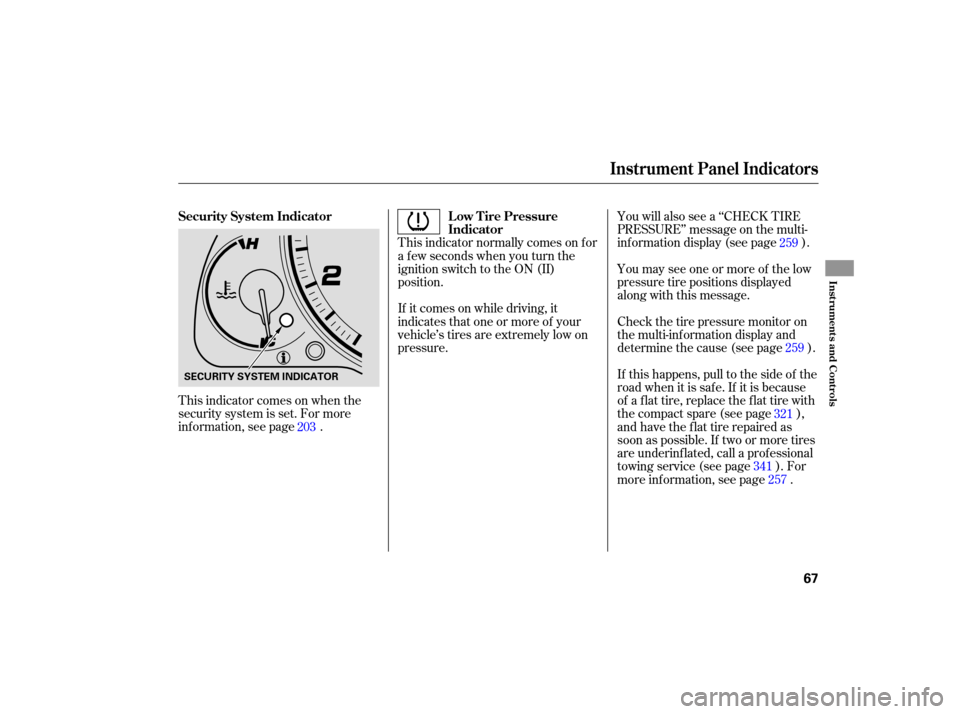
This indicator comes on when the
security system is set. For more
info rmation, see page . This
indicator normally comes on for
a few seconds when you turn the
ignition switch to the ON (II)
position.
If it comes on while driving, it
indicates that one or more of your
vehicl e’s tires are extremely low on
pressure. You
will also see a ‘‘CHECK TIRE
PRESSURE’’ message on the multi-
information display (see page ).
You may see one or more of the low
pressu re tire positions displayed
along with this message.
Check the tire pressure monitor on
the multi -information display and
determine the cause (see page ).
If this happens, pull to the side of the
road when it is safe. If it is because
of a flat tire, replace the flat tire with
thecompactspare(seepage ),
and have the flat tire repaired as
soon as possible. If two or more tires
are underinflated, call a professional
towingservice(seepage ).For
more information, see page .
203 259
321
341 257259
Instrument Panel Indicators
Security System Indicator
Low Tire Pressure
Indicator
Inst rument s and Cont rols
67
SECURITY SYSTEM INDICATOR
Page 74 of 379
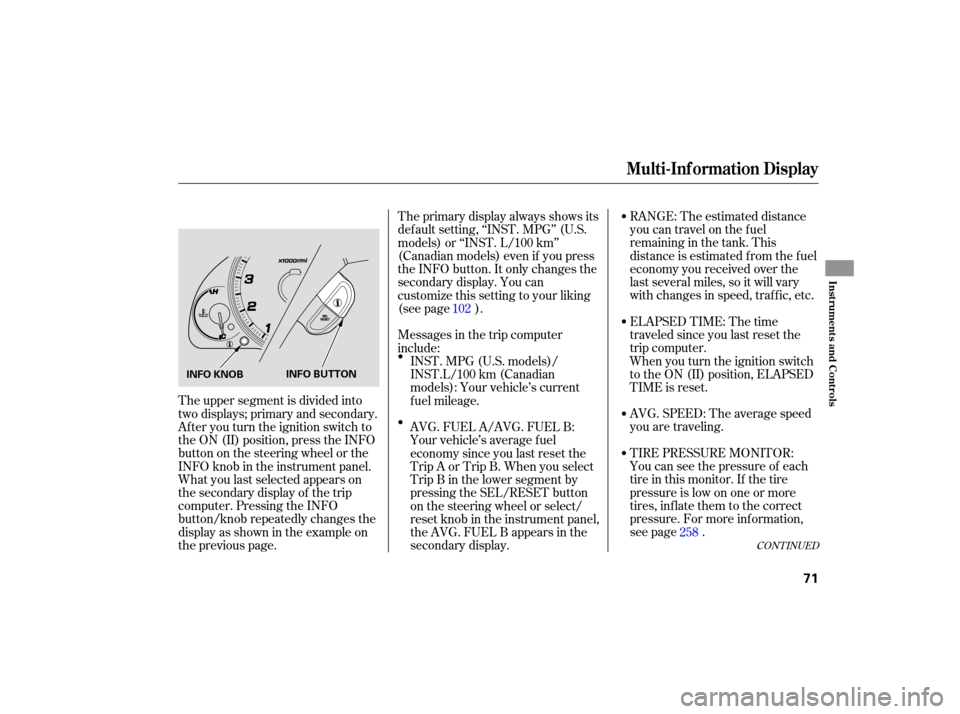
RANGE: The estimated distance
you can travel on the fuel
remaining in the tank. This
distance is estimated from the fuel
economy you received over the
last several miles, so it will vary
with changes in speed, traffic, etc.
ELAPSED TIME: The time
trave led since you last reset the
trip computer.
AVG. SPEED: The average speed
you are traveling.
TIRE PRESSURE MONITOR:
You can see the pressure of each
tire in this monitor. If the tire
pressu re is low on one or more
tires, inflate them to the correct
pressure. For more information,
see page .
The
primary display always shows its
default setting, ‘‘INST. MPG’’ (U.S.
models) or ‘‘INST. L/100 km’’
(Canadian models) even if you press
the INFO button. It only changes the
secondary display. You can
customize this setting to your liking
(see page ).
The upper segment is divided into
two displays; primary and secondary.
After you turn the ignition switch to
the ON (II) position, press the INFO
button on the steering wheel or the
IN FO knob in the instrument panel.
What you last selected appears on
the secondary display of the trip
computer. Pressing the INFO
button/knob repeatedly changes the
display as shown in the example on
the previous page. Messages in the trip computer
include:
When you turn the ignition switch
to the ON (II) position, ELAPSED
TIME is reset.
INST.MPG(U.S.models)/
INST.L/100 km (Canadian
models): Your vehicle’s current
f uel mileage.
AVG. FUEL A/AVG. FUEL B:
Your vehicle’s average fuel
economy since you last reset the
Trip A or Trip B. When you select
Trip B in the lower segment by
pressing the SEL/RESET button
on the steering wheel or select/
reset knob in the instrument panel,
the AVG. FUEL B appears in the
secondary display. 102
258
CONT INUED
Multi-Inf ormation Display
Inst rument s and Cont rols
71
INFO KNOBINFO BUTTON
Page 260 of 379

Your vehicle is equipped with a tire
pressure monitoring system (TPMS)
that turns on every time you start the
engine and monitors the pressure in
your tires while driving.
Each tire has its own pressure
sensor. If the air pressure of a tire
becomes significantly low, the
sensor in that tire immediately sends
a signal that causes the low tire
pressure indicator to come on. Although
your tire pressure is
monitored, you must manually check
thetirepressuresmonthly.
Each tire, including the spare, should
be checked monthly when the
vehicle is cold, and set to the
recommended inflation pressure as
sp ecified on the vehicle placard and
intheowner’smanual(seepage ).
Driving on a significantly under-
inflated tire causes the tire to
ov erheat and can lead to tire failure.
Under-infl ation also reduces fuel
efficiency and tire tread life, and may
affect the vehicle’s handling and
stopping ability. When
the low tire pressure indicator
is on, one or more of your tires is
signifi cantly underinflated. You
should stop and check your tires as
soon as possible, and inflate them to
the proper pressure as indicated on
the vehicle’s tire information placard.
With this indicator on, you will see
which tire is losing the pressure on
the multi-inf ormation display along
with a ‘‘CHECK TIRE PRESSURE’’
message (see page ).
311
259
CONT INUED
Low Tire Pressure
Indicator
Tire Pressure Monitoring System (TPMS)
Driving
257
Page 261 of 379
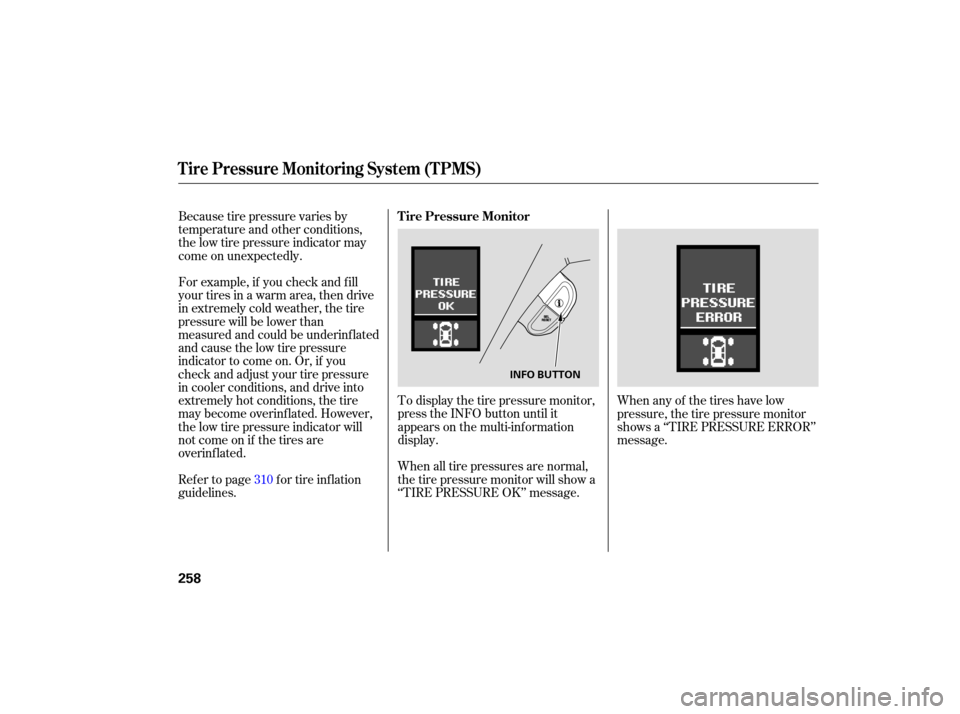
Becausetirepressurevariesby
temperature and other conditions,
the low tire pressure indicator may
come on unexpectedly.
For example, if you check and fill
your tires in a warm area, then drive
in extremely cold weather, the tire
pressure will be lower than
measured and could be underinflated
and cause the low tire pressure
indicator to come on. Or, if you
check and adjust your tire pressure
in cooler conditions, and drive into
extremely hot conditions, the tire
maybecomeoverinflated.However,
the low tire pressure indicator will
not come on if the tires are
overinf lated.
Refer to page for tire inflation
guidelines. To display the tire pressure monitor,
press the INFO button until it
appears on the multi-inf ormation
display.
When all tire pressures are normal,
the tire pressure monitor will show a
‘‘TIRE PRESSURE OK’’ message.When any of the tires have low
pressure, the tire pressure monitor
shows a ‘‘TIRE PRESSURE ERROR’’
message.
310
Tire Pressure Monitoring System (TPMS)
Tire Pressure Monitor
258
INFO BUTTON
Page 263 of 379
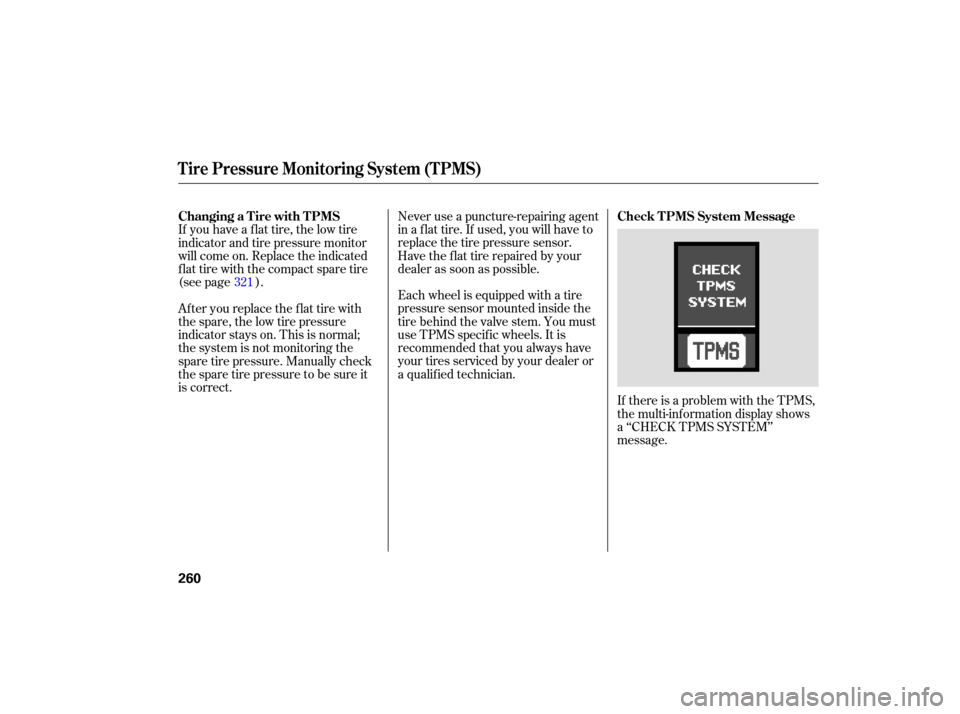
Never use a puncture-repairing agent
in a flat tire. If used, you will have to
replace the tire pressure sensor.
Havetheflattirerepairedbyyour
dealer as soon as possible.
Each wheel is equipped with a tire
pressure sensor mounted inside the
tire behind the valve stem. You must
use TPMS specific wheels. It is
recommended that you always have
your tires serviced by your dealer or
a qualified technician.
After
you replace the flat tire with
the spare, the low tire pressure
indicator stays on. This is normal;
the system is not monitoring the
spare tire pressure. Manually check
the spare tire pressure to be sure it
is correct.
If
you have a flat tire, the low tire
indicator and tire pressure monitor
will come on. Replace the indicated
flat tire with the compact spare tire
(see page ).
If there is a problem with the TPMS,
the multi-information display shows
a ‘‘CHECK TPMS SYSTEM’’
message.
321
Tire Pressure Monitoring System (TPMS)
Check T PMS System Message
Changing a T ire with T PMS
260
Page 271 of 379

When preparing to tow, and before
driving away, be sure to check the
following: Al
ways drive slowly and have
someone guide you when backing up.
Grip the of the steering
wheel; then turn the wheel to the left
to get the trailer to move to the left,
andturnthewheelrighttomovethe
trailer to the right.
Follow all normal precautions when
parking, including firmly setting the
parking brake and putting the
transmission in Park (automatic) or
in first or reverse (manual). Also,
place wheel chocks at each of the
trailer’s tires.
Your
vehicle tires and spare are
properly inflated (see page ),
and the trailer tires and spare are
inflated as recommended by the
trailer maker.
Crosswinds and air turbulence
caused by passing trucks can disrupt
your steering and cause the trailer to
sway. When being passed by a large
vehicle, keep a constant speed, and
steer straight ahead. Do not try to
make quick steering or braking
corrections.
The
vehicle has been properly
serviced, and the suspension,
cooling system, and lights are in
good operating condition.
All weights and loads are within
limits (see pages and ).
Thehitch,safetychains,andany
other attachments are secure.
All items in or on the trailer are
properly secured and cannot shif t
while you drive.
The lights and brakes on your
vehicle and the trailer are working
properly. 264 265
311
bottom
Pre-T ow ChecklistBacking Up
Parking
Handling Crosswinds and Buf f et ing
Towing a Trailer
268
Page 313 of 379

Keeping the tires properly inflated
provides the best combination of
handling, tread life, and riding
comfort.
Underinflated tires wear unevenly,
adversely affect handling and fuel
economy, and are more likely to
fail from being overheated.
Overinflated tires can make your
vehicleridemoreharshly,are
more prone to damage from road
ha zards, and wear unevenly.
To
safely operate your vehicle, your
ti res must be the proper type and
size, in good condition with adequate
tread, and correctly inflated.
The following pages give more
detailed information on how to take
care of your tires and what to do
when they need to be replaced.
Thetirepressuremonitoringsystem
(TPMS)willwarnyouwhenatire
pressure is low. See page f or
inf ormation on the TPMS.
Clean the wheels as you would the
rest of the exterior. Wash them with
thesamesolution,andrinsethem
thoroughly.
Aluminum alloy wheels have a
protective clear-coat that keeps the
aluminum f rom corroding and
tarnishing. Cleaning the wheels with
harsh chemicals (including some
commercial wheel cleaners) or a stif f
brush can damage the clear-coat. To
clean the wheels, use a mild
detergent and a sof t brush or sponge.
257
Inf lation Guidelines
Tires
Wheels
Wheels, Tires
310
Using tires that are excessively
worn or improperly inflated can
cause a crash in which you can
be seriously hurt or killed.
Follow all instructions in this
owner’s manual regarding tire
inflation and maintenance.
Page 322 of 379

This section covers the more
common problems that motorists
experience with their vehicles. It
gives you inf ormation about how to
safely evaluate the problem and what
to do to correct it. If the problem has
stranded you on the side of the road,
you may be able to get going again.
If not, you will also f ind instructions
on getting your vehicle towed.......................
Compact Spare Tire .320
....................
Changing a Flat Tire .321
..........
If Your Engine Won’t Start . 325
................................
Jump Starting .327
............
If Your Engine Overheats . 329
.........
Low Oil Pressure Indicator . 331
..........
Charging System Indicator . 332
.......
Malf unction Indicator Lamp . 332
.......................
Readiness Codes .333
...............
Brake System Indicator . 334
..................
Closing the Moonroof . 335
..............................................
Fuses .336
..............................
Fuse Locations .339
......................
Emergency Towing .341
Taking Care of the Unexpected
T aking Care of t he Unexpect ed
319
Page 323 of 379
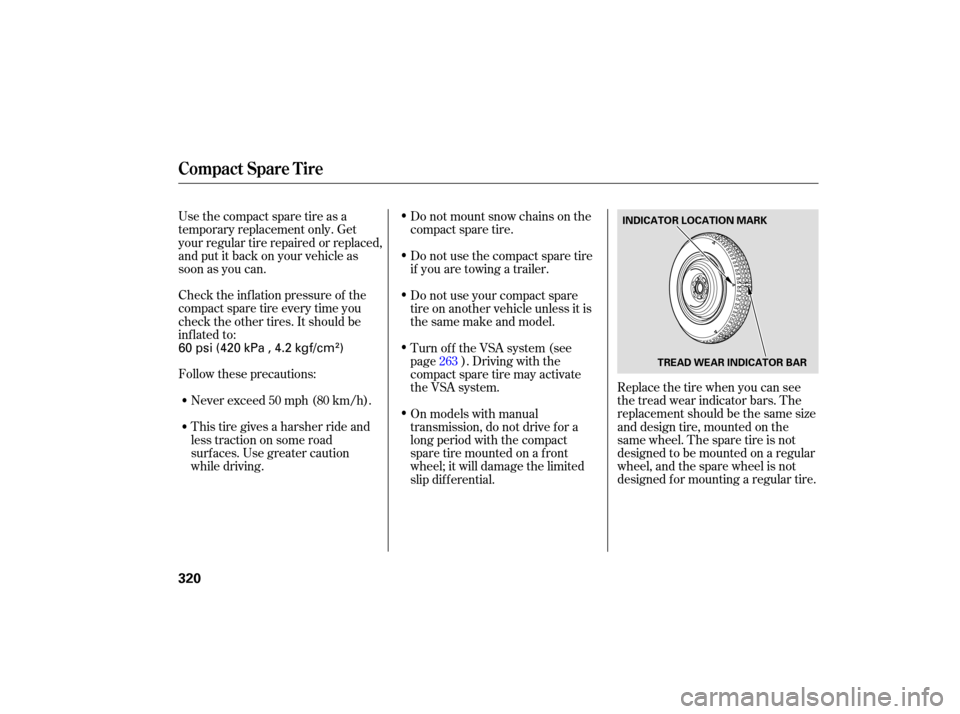
Check the inflation pressure of the
compact spare tire every time you
check the other tires. It should be
inflated to:
Follow these precautions:
Never exceed 50 mph (80 km/h).
This tire gives a harsher ride and
less traction on some road
surfaces. Use greater caution
while driving. Do
not mount snow chains on the
compact spare tire.
Do not use the compact spare tire
if you are towing a trailer.
Replace the tire when you can see
the tread wear indica tor bars. The
replacement should be the same size
and design tire, mounted on the
samewheel.Thesparetireisnot
designed to be mounted on a regular
wheel, and the spare wheel is not
designed for mounting a regular tire.
Use
the compact spare tire as a
temporary replacement only. Get
your regular tire repaired or replaced,
and put it back on your vehicle as
soon as you can.
Do not use your compact spare
tire on another vehicle unless it is
thesamemakeandmodel.
On models with manual
tran smission, do not drive for a
long period with the compact
spare tire mounted on a f ront
wheel; it will damage the limited
slip dif f erential. Turn of f the VSA system (see
page ). Driving with the
compact spare tire may activate
the VSA system. 263
Compact Spare Tire
320
INDICATOR LOCATION MARK
TREAD WEAR INDICATOR BAR
60 psi (420 kPa , 4.2 kgf/cm)
Page 324 of 379
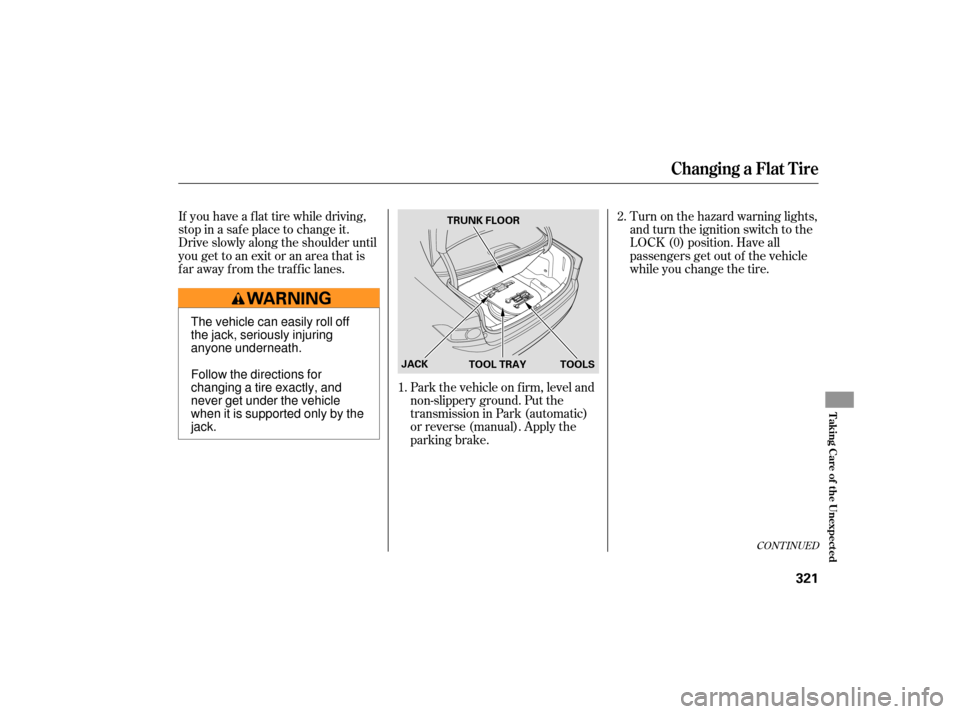
CONT INUED
Park the vehicle on f irm, level and
non-slippery ground. Put the
transmission in Park (automatic)
or reverse (manual). Apply the
parking brake.
If you have a f lat tire while driving,
stop in a saf e place to change it.
Drive slowly along the shoulder until
you get to an exit or an area that is
far away from the traffic lanes.
Turn on the hazard warning lights,
and turn the ignition switch to the
LOCK (0) position. Have all
passengers get out of the vehicle
while you change the tire.
2.
1.
Changing a Flat Tire
T aking Care of t he Unexpect ed
321
TRUNK FLOOR
JACK TOOLS
TOOL TRAY
The vehicle can easily roll off
the jack, seriously injuring
anyone underneath.
Follow the directions for
changing a tire exactly, and
never get under the vehicle
when it is supported only by the
jack.